Answer.
APPROACH
Introduction- Define earthquake and mention its causes.
The Body
- Start with a description of the global distribution of earthquakes- Must link the causes and examples that are relevant.
- Draw related diagrams and maps.
- Then discuss strike-slip earthquakes and the case of Turkey-Syria.
- Explain the involvement of tectonic plates that led to such disaster.
- Draw any one diagram to show the transform boundary and movement of plates.
Conclusion- Briefly mention the effects of earthquakes and vulnerability of India. Suggest briefly what measures can help reduce the casualties and losses from such earthquakes.
Introduction: The release of energy along a fault generates waves that lead to the shaking of the earth, which is understood as an earthquake. All earthquakes occur in the lithosphere, which is a portion of the earth up to a depth of 200 km from the surface of the earth. Earthquakes are generated due to various factors such as interaction of tectonic plates and release of energy at epicentre, reservoir-induced seismicity (E.g., case of Koyana dam), volcanic eruption, mining and explosion.
The Body-
Global distribution of earthquakes:
The Plate Tectonics Theory justifies the occurrence of both inter-plate and intra-plate earthquakes. Earthquakes are common to occur in the case of all plate margins, be it the case of converging tectonic plates or diverging plates or transform faults. Majority of the earthquakes are known to occur in the following regions/zones:
1. Circum-Pacific Belt or Ring of Fire: Nearly 80% of the global earthquakes occur within this zone, which is seismically very active due to the presence of various plate margins. Both convergence and divergence of plates are witnessed within this belt. It traces the boundary between numerous tectonic plates such as the Pacific, Juan de Fuca, Cocos, Nazca, North American and Philippines plates.
The subduction of the denser plate under a lighter tectonic plate in a Benioff zone during convergence causes the earthquakes. Similarly, when two plates diverge or slide past one another, seismic waves are produced along the fault line as energy is energy from the epicentre or in conjunction with the volcanic eruption.
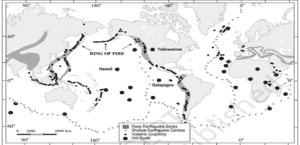
2. Alpine-Himalayan belt: Nearly 15% of the earthquakes occur within this seismically-active belt that stretches from Java to Sumatra through the Himalayas, the Mediterranean, towards the Alps and Atlantic. This belt is characterized by orogenic activities due to the convergence of the tectonic plates. The seismicity is the aftermath of the processes of subduction, folding and warping of the crustal portions. For instance– Earthquakes occur in response to contracting crust and Himalayan formation when the Indian plate converges with the Eurasian plate.
3. Mid-oceanic ridge or spreading zones: The central portion of the Mid-Oceanic Ridge in the Atlantic Ocean experiences intense volcanic activity and earthquakes simultaneously. It is attributed to the spreading ocean caused by the divergence of the North American Plate and the Eurasian Plate in the north and the South American Plate and the African Plate in the south.
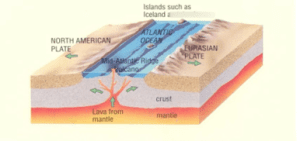
4. Rift valleys of East Africa: On the western edge of the African Plate is a divergent plate boundary. The East African Rift Zone is developing with the faulting and tearing apart of the Somali plate. Such plate movements cause earthquakes.
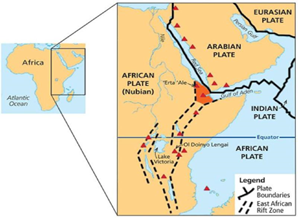
STRIKE-SLIP EARTHQUAKE:
Strike-slip earthquake is generated due to the strike-slip faults, also known as transform faults.
In the case of transform boundaries, the crust is neither destroyed nor produced; rather, the plates slide past each other horizontally, and the friction between such two tectonic plates keeps building up the stress. Once the stress accumulated exceeds the friction, energy is burst in the form of an earthquake along the fault, which develops in the zone of weakness in the earth’s crust.
The San Andreas Fault is one of the most renowned strike-slip faults that have led to several earthquakes in California, USA.
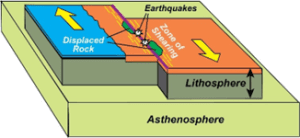
CASE OF TURKEY-SYRIA EARTHQUAKE:
Two earthquakes exceeding magnitude of 7 hit Turkey and Syria in February 2023, having epicentre near Gaziantep town of Turkey. The earthquakes were caused because of the transform boundary that developed between the Arabian plate and the Anatolian plate.
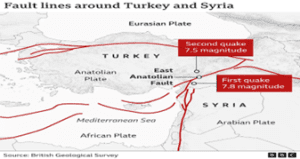
The Arabian plate, while moving Northwards, ground past the Anatolian plate, and with these two tectonic plates sliding past each other, the stress accumulation and friction eventually manifested as the sudden release of energy at the fault line, triggering massive earthquakes.
Conclusion- The earthquakes over magnitude of 7 caused huge devastation and losses of life, property and economy. Nearly 59% of India’s landmass is prone to earthquakes, and cities with high population loads, such as Delhi, are located on fault lines. Therefore, it becomes crucial to ensure a robust disaster management framework is enforced in line with Sendai Framework. The need of the hour is to enforce strict building codes and standards, increase investments in R&D to further understand earthquakes, ensure proper land-use planning and strengthen the emergency response.
Spread the Word
